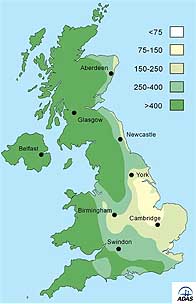Crop uptake is important guide to N top dressings

Be sure to take the amount of nitrogen already absorbed by crops into account when determining top-dressing tactics this season, ADAS is urging growers.
After the wetter than average winter in most arable areas, the temptation might be to assume that much N has been leached from the land.
But soil N reserves were high last autumn, and excess winter rainfall should not be used in isolation on cropped land to assess soil nitrogen supply (SNS), advises principal scientist Peter Dampney.
“There tends to be confusion between soil mineral nitrogen (SMN) and total SNS.”
It is important to remember that any calculation of SNS must also include an assessment of how much N was in the crop when the soil sample was taken (see table), plus an estimate of the N that will be mineralised from soil organic matter, says Mr Dampney.
Crops grew unusually well during the mild winter and took up significant amounts of N, so minimising leaching losses, he notes.
Provided SMN sampling, which should have been taken in three depth layers to 90cm, and the analyses were done correctly, the results will be an important basis for N decisions, says Mr Dampney.
“But ignoring the amount of N in the crop and any mineralisable, N will give a misleadingly low estimate of the SNS,” he warns. “This will be particularly so where the soil samples have been taken in advanced, lush crops.”
The method should be targeted to fields on medium or heavy soils that are likely to have high soil N residues in the autumn, for instance where organic manures have been regularly applied.
| N-Crop assessment | |
| Cereal shoots/m2 | Crop N content (kg/ha) |
| 500 | 5-15 |
| 1000 | 15-25 |
| 1500 | 25-50 |
| OSR crop height (cm) | |
| 10 | 35-45 |
| 15 | 55-65 |
| 20 | 75-85 |
| 25 | 95-105 |
| 30 | 115-125 |
“Sampling sandy or shallow soils is much less likely to be worthwhile, as the nitrogen is very quickly leached from them.”
The amount of N mineralised on the vast majority of arable soils is “negligible”, he says.
However, the N supplied by autumn applications of organic manure should always be taken into account, for example by using MANNER or PLANET software, he advises. But after the wet winter levels this spring may be lower than average.
“Farmers and advisers should estimate the breakeven ratio before making final decisions on N rates,” he adds. “With firmer cereal prices, a breakeven ratio of around five, that is 5kg of grain needed to pay for 1kg of N, may be appropriate for many cereal crops.
“Using this ratio would mean a reduction of 15-20kg/ha to a typical RB209 recommendation of 200kg/ha of N.”

